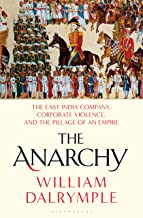The Anarchy by William Dalrymple reviewed by William P. Meyers
June 28, 2022
Popular pages:
| U.S. War Against Asia |
| Fascism |
| Democratic Party |
| Republican Party |
| Natural Liberation |
The Anarchy, The East India Company, Corporate Violence, and the Pillage of an Empire Bloomsbury Publishing, 2021 edition, paperback, $20.00

In 1700 the world's two largest economies were those of India and China. In Europe Spain had the leading economy, based largely on extracting wealth from its American colonies. The world's population stood at perhaps one-half billion. England's population was between 6 and 7 million, and while the first signs of the Industrial Revolution were evident, its economy was still mainly agricultural. The British Empire consisted of a few islands in the Caribbean and the colonies along the North American coast that would later become the United States, plus a few trading outposts in Africa and Asia. Even the tiny state of Holland was much more powerful and prosperous than England.
Enter the East India Company, formed in 1599 at the behest of Thomas Smythe, Auditor of the City of London. Experienced merchant shippers, pirates (often the same people), and investors joining together under his leadership, put in a bunch of money. The government gave them a trade monopoly for Asia or the West Indies, but they proceeded to have a difficult century. Still, in the 1600s they did establish trading posts in India, which was far more populated and far richer than England. In 1690 they established a settlement at Calcutta (Kolkata). This was in the region known as Bengal: "The Company existed to make money, and Bengal, they soon realised, was the best place to do it."
During the next century the Company always traded, often stole, and sometimes went to war. India's cohesive central government was starting to fissure even before the Brits arrived. It was a long slow process. The main Company strategy was to divide and conquer. India had many ethnic groups and several languages, and often even within kingdoms various relatives fought over the throne. The Anarchy is long on the details, with great insights into Indian and British culture and characters.
In the process of the Company, soon an arm of the British Empire, taking over India, it destroyed much of the Indian economy. One result was the Bengal famine of 1769 to 1771. In part the famine was due to drought, but it was also due to Company mismanagement, including grabbing what rice they could to sell at high prices. Famines have occurred throughout history, usually caused by weather, but sometimes by war or other human folly. In the USA we are taught to think of famines as natural in parts of Africa, and otherwise caused by communism, for instance the one in China blamed on Mao and his Great Leap Forward. One problem for Bengal was that, by 1769, its economy was already largely destroyed by the Company, and so natives did not have the financial means to import food from other parts of India.
Great Britain became the wealthiest nation in the world between about 1750 and 1850 through a confluence of changes. Early on slave trade and sugar plantations created wealth. The industrial revolution underpinned economic growth. Wealth looted from India had a big impact, helping to finance both the industrial revolution and the expansion of the British Empire. Tea, too played a part, especially after the Company learned to grow it in India (on land confiscated from natives). Finally, there was opium, grown in India and sold to the Chinese. The Chinese Emperors had outlawed it, but the Brits ran it in illegally until they fought the Opium Wars to create a legal trade. Opium both drained China of money and debilitated its inhabitants, causing China to drop from being the greatest power in the world in 1800 to a shadow of its former self by 1900.
Though it is not the focus of the book, it is clear that the American Revolution was a sideshow. Who could bother with subduing a bunch of scrawny corn and tobacco farmers when the same money and troops could conquer a far richer and more populous nation? It makes me suspect that our Independence was won when some Company accountant in London said: the return on investment just is not there in the bloody American colonies. Especially since they were not likely to return to being customers of Company tea.
There are parallels between the divide-and-conquer techniques of the Company in India and the success of European settlers, in what would become the United States, against the native Americans. Because of their wealth, many of the Indian heads of state were able to match the Brits in military equipment and tactics. But they were seldom able to present a united front. American Indian tribes may not have had the numbers or technology or organized states of the Asian Indians, but their real weakness was an inability to unite. United, they might have held the colonists to the Line of 1763.
Despite the plague of overpopulation, India has recovered fairly well from the cruel rule of the Company and the British Empire. The world, however, is still a playground for human folly as we head into the Slow Motion Apocalypse. The Anarchy brings to light many of the mistakes people have made in the past. Sadly, it is a book about how to get rich, not a book about the triumph of resistance movements, or of mutual cooperation for a better world.
| Copyright 2022 William P. Meyers. All rights reserved. |
